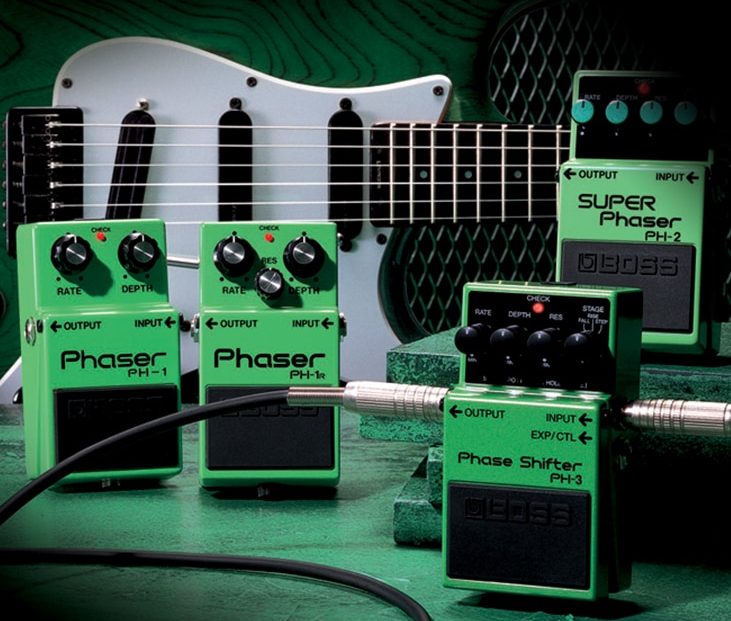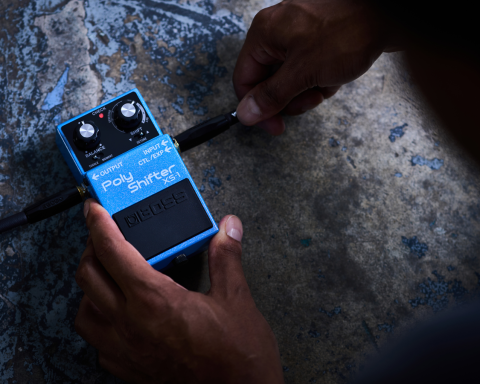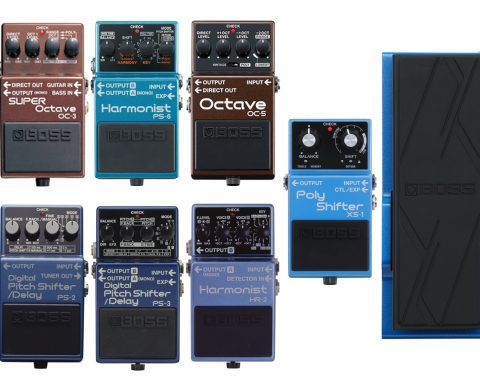Phaser is a naturally versatile modulation effect. Using it with a simple, clean guitar tone can elevate any garden variety chord progression and unleash one’s inner Pink Floyd. But pairing a phaser with other effects opens up a new realm of creative guitar tones. The best thing about phaser is that it works with almost every other effect type. From overdrive to reverb, it can enhance, expand, and excite a guitar tone.
Combining Pedals
As a modulation effect, phaser can work in several different effects chain positions, depending on how the player pairs it. Overdrives and distortions should always go ahead of the phaser, allowing it to lift your drive tone an extra notch. Delays and reverbs should come after the phaser to enable more complex processing without getting squashed by the phaser.
PEDAL COMBINATIONS
Overdrive
The most widely used pairing for a phaser is with an overdrive. Phaser manipulates the treble frequencies of the guitar signal as it moves in and out of phase with itself. As it does so, it creates extreme harmonic variations with overdrive. There are countless examples of this pairing in modern music. Listen to Led Zeppelin’s “The Rover” or Ozzy Osbourne’s “Bark at the Moon” and hear that classic combination of overdrive alongside a slow phaser wave.
Yet the most famous use of overdrive and phaser together is the flamboyant lead tone of Eddie Van Halen’s opening guitar solo on “Eruption.” The combination of a finger-tapped guitar solo with overdrive and a phaser, with a high-depth setting but a slow effect rate, is a staple tone. It’s simple, effective, and quintessentially rock and roll.
Recommended Pairings
- BOSS PH-3 and DS-1W
- BOSS PH-3 and BD-2W
Fuzz
A phaser can be a great addition to the brutally aggressive buzz of a heavily gated modern fuzz pedal. Modern fuzzes create an almost square soundwave. Although sonically pleasing, this sound lacks any form of dynamics. Used in a mix with other instruments, this can sometimes sound flat and needs help to cut through. Adding the shifting warp of a phaser can focus some of those frequencies necessary to cut through a mix and excite the fuzz pedal’s tone.
In this situation, set the phaser’s depth control relatively high and the rate control to a slow speed. The phaser’s cascading movement can elevate the fuzz effect and create an exciting, new synth-like tone.
Recommended Pairing
- BOSS PH-3 and FZ-1w
"A phaser can be a great addition to the brutally aggressive buzz of a heavily gated modern fuzz pedal."
Octave and Tremolo
A phaser can be an excellent tool for guitarists looking to create wild synth tones with their instruments. Used with an octave pedal and a tremolo, the synth-like capabilities of this trio are almost infinite.
For this combination, position the effects with the octave pedal first, followed by the tremolo, and finally, the phaser. The octave pedal should have the sub-octave levels on full and the dry guitar signal cut completely. This setting gives the guitar a more synthetic, less dynamic, bass-like tone. Next, set the tremolo at a medium rate with the depth control rolled fully clockwise. In this instance, the tremolo effect emulates the pulsing arpeggiator of a synthesizer. Finally, the phaser should be at a high depth and medium rate. The phaser pedal’s role in this setup is to emulate the cascading movement of a synthesizer LFO.
With all three pedals engaged, play simple single-note progressions in time with the pulse of the tremolo. Voila! Instant guitar synthesizer.
Recommended Pairing
- BOSS PH-3, OC-5, and TR-2
Delay
Phaser can be a powerful effect to help excite and expand a simple delay pedal. In tandem, these effects can create some super spacey, ambient textures. Mike Einziger of Incubus is a fantastic example of a guitarist who uses this combination frequently.
A standard method Einziger employs with this combination is the “volume roll.” He’ll strum a chord with the guitar volume rolled off and then slowly roll the volume on, creating a swelling effect. This method, coupled with high feedback and effect level on the delay and an increased depth and medium rate on the phaser, creates a dreamy tone perfect for psychedelic song sections.
Recommended Pairings
- BOSS PH-3 and RE-202
- BOSS PH-3 and DM-2W

Reverb
A perfect pairing for creating super sci-fi, ambient soundscapes is that of phaser and reverb. The vast ethereal echo of a reverb effect coupled with a soaring wave of phaser can make your guitar sound like it’s from another dimension. It’s also a common pairing in some of the more ambient dub and reggae remixes by Lee “Scratch” Perry. This combination works like pairing a phaser with delay, but it can work with the two pedals in either order.
For a gentler result, position the phaser before the reverb. Set the phaser to around 8 o’clock with the depth at almost full. This will create a very slowly cresting wave of phasing beneath the ambient reverb effect. Set the reverb to a high effect level and time for maximum soundscape texture.
"A perfect pairing for creating super sci-fi, ambient soundscapes is that of phaser and reverb."
Position the phaser after the reverb for a more extreme, phaser-focused result. This will allow the phaser to affect the multiple echoes of the reverb more directly. For this to work, the phaser’s depth control will need to get dialed back so as not to be too overpowering. The result will be less ambient and more in the realm of sci-fi. Still, it can be an extremely effective alternative tone.
Recommended Pairings
- BOSS PH-3 and RV-6
- BOSS PH-3 and RV-500

Modulation Swiss Army Knife
Phaser is, in many ways, the Swiss Army Knife of modulation. It can be a gentle lift for an overdrive or a searing wave for a bass synth. It works well in almost any situation and can do a similar job to several other modulation pedals. Combine it with octaves, delays, or reverbs—even other phasers—for some exciting, classic guitar tones. It’s a pedalboard essential, and no good guitarist should leave home without one.







